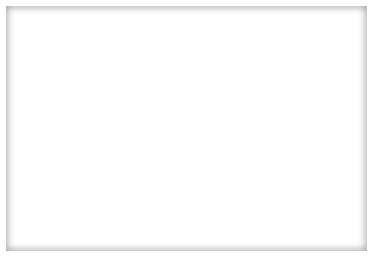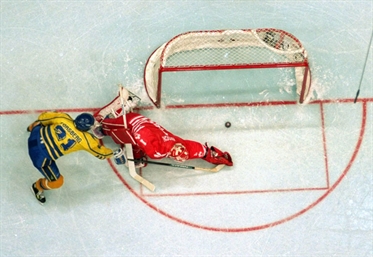Revisiting 1994
Revisiting 1994
Canada, Sweden met once before for OG gold

 Sweden's Peter Forsberg will always be remembered for arguably the coolest shot in hockey at the 1994 Olympics against Canadian goalie Corey Hirsch. Photo: Al Behrman / Associated Press
Sweden's Peter Forsberg will always be remembered for arguably the coolest shot in hockey at the 1994 Olympics against Canadian goalie Corey Hirsch. Photo: Al Behrman / Associated Press
The road these two teams took to the final on February 27 at the Hakon Hall was full of intrigue.
Sweden was eager to top the Olympic podium for the first time ever. Tre Kronor had won six IIHF World Championships all-time at this point, two as recently as 1991 and 1992 under Conny Evensson, the predecessor of now-coach Curt “Curre” Lundmark. They were looking for redemption after Lundmark’s boys were dethroned in a 3-1 loss to Russia in the 1993 World Championship final in Germany.
Looking at the ‘94 Swedish roster, it was by no means self-evident that this group would have what it took to win it all. Goalie Tommy Salo was having a middle-of-the-road season with Vasteras IK of the Swedish Elitserien. The best-known name on defence was Tomas Jonsson, a skillful puck-mover who won two Stanley Cups with the New York Islanders in 1981 and 1982 before returning to Sweden in 1989 for a long stint with Leksands IF.
Up front, it was a blend of other slightly-past-their-prime ex-NHLers, like forwards Hakan Loob and Mats Naslund, with emerging Eliteserien stars like Jorgen Jonsson and Peter Forsberg. The latter had made a name for himself at the 1993 World Juniors with a tournament-record 31 points as Sweden took the silver medal, and was already being touted by some as the world’s best player outside the NHL.
The Canadians came into Lillehammer seeking to end a gold medal drought that stretched back to another Olympics held in Norway: the 1952 Winter Games in Oslo, where the Edmonton Mercurys senior men’s team garnered the title.
At 39, coach Tom Renney was regarded as one of the bright young minds in the game as he took over from Dave King, who’d left Hockey Canada after losing the 1992 Olympic final 3-1 to Russia in Albertville, France.
This was the last time we’d see Canada represented at the Olympics by a standing national team. For the 1998 Winter Games in Nagano, Japan, the NHL would finally accept the offer from the IOC and IIHF that had been open since 1988 and send all of its best players to compete.
In Lillehammer, Renney would ride 21-year-old netminder Corey Hirsch from start to finish in the eight-game run. (They’d continue their association in the NHL when Renney coached Hirsch’s Vancouver Canucks.) The blue line included the likes of Adrian Aucoin and Chris Therien, both of whom would go on to play more than 700 NHL games. The forwards were a workmanlike lot, with two notable exceptions: Paul Kariya and Petr Nedved.
Both these talented youngsters were in NHL contract limbo, so to speak. Kariya, 19, had to yet to agree on a deal with the Anaheim Mighty Ducks, who had taken him fourth overall in the 1993 NHL draft, and was committed to playing at the Olympics. The 22-year-old Nedved, coming off a 38-goal campaign with the Vancouver Canucks, couldn’t come to terms on a new deal either. So the Czech-born centre, who had secured Canadian citizenship, hooked up with the national team to keep fit – and wound up making the Olympic roster.
When the 12-team tournament kicked off on February 12, Sweden and Canada were in Pool B together. They finished with identical records of three wins, one tie, and one loss.
Canada fell 3-1 to a Slovak squad headlined by Zigmund Palffy, Miroslav Satan, and Peter Stastny, who would finish 1-2-3 in tournament scoring. But the Canadians edged Sweden 3-2 to close out the round-robin on a Nedved goal.
It was Kariya’s turn to play the hero in the quarter-finals, scoring at 5:54 of overtime to give Canada a 3-2 win over the Czechs. Meanwhile, Sweden earned a routine 3-0 win over Germany.
In the semi-finals, Canada would down Finland 5-3 – not a small feat, considering the Finns had already humbled Russia 5-0 and would blank them again, 4-0, for bronze. The Swedes dispatched Russia 4-3, buoyed by two Patrik Juhlin goals and three assists from Forsberg.
Now it was time for what Sports Illustrated would call, at the time, “the most exciting game in Olympic hockey history.”
The final was pure intensity. Tomas Jonsson opened the scoring for Sweden five minutes in, and Tre Kronor pounded away at Hirsch without managing to extend its lead deep into the third period.
Then the tide turned in Canada’s favour. With about 11 minutes left, Kariya deflected home a Chris Kontos shot to tie the game up, and two minutes later, defenceman Derek Mayer beat Salo on a screened shot. Could the Canadians hang on?
The answer was no. Blueliner Brad Werenka was called for hauling down Mats Naslund in the slot with 2:10 left, and defenceman Magnus Svensson scored on a center point blast just 22 seconds later.
When a 10-minute overtime settled nothing, it was off to the shootout.
The fans were in agony as the game-winning shots competition reached its sudden-death phase. Both Svensson and Nedved missed on their first shots.
Then Peter Forsberg pulled off the move that would make him an international hockey legend and put him on a Swedish postage stamp. He skated in on Hirsch, deked the netminder, and then slid the puck backhanded into the net, using just his right hand. Hirsch nearly got it, but it slid past his glove.
Now Paul Kariya had to score for Canada. Racing in, he went high on Salo, but the Swedish netminder sprawled and kicked away the puck with his left pad up in the air. The Swedes jubilantly mobbed their goaltender. Canada’s gold medal drought would endure until Salt Lake City 2002.
If Sunday’s gold medal game between Canada and Sweden at the Bolshoy Ice Dome contains anything like the same amount of drama, fans are in for a real treat.
Back to Overview











































